Decision Making Methods to Optimize New Dam Site Selections on the Nitra River
Abstract
1. Introduction
2. Materials and Methods
2.1. Case Study
2.2. Demarcation of the Partial River Basins of Reservoirs
2.3. Calculation of the Volume of Surface Runoff from Reservoirs River Basins
2.4. Calculation of Soil Loss by Water Erosion
- River basin area: identified area of individual reservoirs river basins up to the reservoir’s final profile.
- Arable and forested land: area of arable and forested land calculated for each river basin by current use, based on interpreted ZBGIS data and Land Register maps.
- Built-up areas in the river basin: based on outputs from current use of the area, while specifying built-up areas in each river basin.
- Erosion: erosion assessed from individual SEOP categories at each river basin in the five categories.
- Volume of surface runoff towards the final reservoir profiles: calculated volume of surface runoff towards the final profile, using the runoff curve number method (CN-method).
- No predetermined number of clusters has to be specified;
- Identification of larger clusters (to put new dam areas in for comparison);
- It is a recommended robust technique [40,41] with an available implementation (https://www.r-project.org/, retrieved at: 29 February 2020).
3. Results and Discussion
Detailing River Basin Reservoirs from All Assessed Criteria
4. Conclusions
Author Contributions
Funding
Conflicts of Interest
References
- Briney, A. Dams and Reservoirs. Available online: https://thoughtco.com/dams-and-reservoirs-1435829 (accessed on 11 February 2020).
- Just, T.; Moravec, P.; Šámal, V.; Frnková, L. Obnova Malých Vodních Nádrží Jako významných Krajinných Prvků [Restoration of Small Water Reservoirs as Important Landscape Elements], 1st ed.; Agentúra Ochrany Přírody a Krajiny České Republiky: Praha, Czech Republic, 2009. [Google Scholar]
- Munoth, P.; Munoth, R. Impacts of Land Use Land Cover Change on Runoff and Sediment Yield of Upper Tapi River Sub Basin, India. Int. J. of River Basin Manag. 2020, 18, 177–189. [Google Scholar] [CrossRef]
- Jakubcová, A.; Grežo, H. Impacts of Flooding on the Quality of Life in Rural Regions of Southern Slovakia. Appl. Res. Qual. Life 2016, 1, 221–237. [Google Scholar] [CrossRef]
- Jurík, Ľ.; Zeleňáková, M.; Kaletová, T.; Arifjanov, A. Small Water Reservoirs: Sources of Water for Irrigation. In Water Resources in Slovakia. Part 1; Negm, A.M., Zeleňáková, M., Eds.; Springer International Publishing Birkhäuser Verlag AG: Basel, Switzerland, 2018; pp. 115–131. [Google Scholar] [CrossRef]
- Grabic, J.; Bezdan, A.; Benka, P.; Salvai, A. Spreading and Transformation of Nutrients in the Reach of the Becej-Bogojevo Canal, Serbia Spreading and Transformation of Nutrients in the Reach of the Becej-Bogojevo Canal, Serbia. Carpathian. J. Earth Environ. Sci. 2011, 6, 277–284. [Google Scholar]
- Muchová, Z.; Tárníková, M. Land Cover Change and its Influence on the Assessment of the Ecological Stability. Appl. Ecol. Environ. Res. 2018, 16, 2169–2182. [Google Scholar] [CrossRef]
- Tárník, A.; Leitmanová, M. Analysis of the Development of Available Soil Water Storage in the Nitra River Catchment. In IOP Conference Series-Materials Science and Engineering; IOP Publishing LTD, Dirac House, Temple Back, Bristol BS1 6BE, England; IOP Publishing: Prague, Czech Republic, 2017. [Google Scholar] [CrossRef]
- Dundjerski, J.J.; Savic, R.; Grabic, J. Water Quality Trends of the Tisa River along Its Flow through Serbia. Annu. Set Environ. Prot. 2017, 19, 17–35. [Google Scholar]
- Izakovičová, Z.; Špulerová, J.; Petrovič, F. Integrated Approach to Sustainable Land Use Management. Environments 2018, 5, 37. [Google Scholar] [CrossRef]
- Jurík, L.; Húska, D.; Halászová, K.; Bandlerová, A. Small Water Reservoirs—Sources of Water or Problems? J. Ecol. Eng. 2015, 16, 22–28. [Google Scholar] [CrossRef]
- Lepška, T. Ecohydrology & Hydrobiology Hydric Potential of Selected River Basins in Slovakia. Ecohydrol. Hydrobiol. 2013, 13, 201–209. [Google Scholar] [CrossRef]
- Brath, A.; Montanari, A.; Moretti, G. Assessing the Effect on Flood Frequency of Land Use Change via Hydrological Simulation (with Uncertainty). J. Hydrol. 2006, 324, 141–153. [Google Scholar] [CrossRef]
- Langhammer, J.; Vilímek, V. Landscape Changes as a Factor Affecting the Course and Consequences of Extreme Floods in the Otava River Basin, Czech Republic. Environ. Monit. Assess. 2008, 144, 53–66. [Google Scholar] [CrossRef]
- Jurík, Ľ.; Halászová, K.; Pokrývková, J.; Rehák, Š. Irrigation of Arable Land in Slovakia: History and Perspective. In Water resources in Slovakia. Part 1; Negm, A.M., Zeleňáková, M., Eds.; AG, Springer International Publishing: Basel, Switzerland, 2018; pp. 81–96. [Google Scholar] [CrossRef]
- Wojkowski, J.; Młyński, D.; Lepeška, T.; Wałęga, A.; Radecki-Pawlik, A. Science of the Total Environment Link between Hydric Potential and Predictability of Maximum Fl Ow for Selected Catchments in Western Carpathians. Sci. Total Environ. J. 2019, 683, 293–307. [Google Scholar] [CrossRef] [PubMed]
- Štátny vodohospodársky plán Československej Republiky. In Hlavné Povodie Dunaja. Čiastkové povodie XXIX—Nitra. Diel II. a III.—Text. [State Water Management Plan. of the Czechoslovak Republic. The Main Catchment Area of the Danube. Partial Catchment Area XXIX—Nitra. Part. II. a III. —Text.]; Vodohospodárke Rozvojové Stredisko, Water Management Development Centre: Bratislava, Slovakia, 1956.
- Havlíček, M.; Pavelková, R.; Frajer, J.; Skokanová, H. The Long-Term Development of Water Bodies in the Context of Land Use: The Case of the Kyjovka and Trkmanka River Basins (Czech Republic). Morav. Geogr. Rep. 2014, 22, 39–50. [Google Scholar] [CrossRef]
- Tárník, A.; Igaz, D. Spatial Scale Analysis of Soil Water Content in Agricultural Soils of the Nitra River Catchment (Slovakia). J. Ecol. Eng. 2020, 21, 112–119. [Google Scholar] [CrossRef]
- Ya, L.; Zhao, C.; Yang, S.; Cai, M.; Zhou, Q. A Soil Erosion Assessment of the Upper Mekong River in Yunnan Province, China. Mt. Res. Dev. 2014, 34, 36–47. [Google Scholar] [CrossRef]
- Schuetze, T.; Chelleri, L. Climate Adaptive Urban Planning and Design with Water in Dutch Polders. Water Sci. Technol. 2011, 722–730. [Google Scholar] [CrossRef] [PubMed]
- Mosley, L.M. Earth-Science Reviews Drought Impacts on the Water Quality of Freshwater Systems; Review and Integration. Earth Sci. Rev. 2015, 140, 203–214. [Google Scholar] [CrossRef]
- Karásek, P.; Konečná, J.; Pochop, M.; Kučera, J.; Podhrázská, J. Priority Areas for Initiating Land Consolidations Related to Erosion and Water Retention in the Landscape, Czech Republic. J. Ecol. Eng. 2018, 19, 16–28. [Google Scholar] [CrossRef]
- Petrovič, F.; Stránovský, P.; Muchová, Z.; Falťan, V.; Skokanová, H.; Havlíček, M.; Gábor, M.; Špulerová, J. Landscape-Ecological Optimization of Hydric Potential in Foothills Region with Dispersed Settlements—A Case Study of NovÁ BoŠÁca, Slovakia. Appl. Ecol. Environ. Res. 2017, 15. [Google Scholar] [CrossRef]
- Pavelková, R.; Frajer, J.; Havlíček, M.; Netopil, P.; David, V.; Dzuráková, M.; Šarapatka, B. Historical Ponds of the Czech Republic: An Example of the Interpretation of Historic Maps. J. Maps 2016, 5647, 551–559. [Google Scholar] [CrossRef]
- Zhang, H.; Jin, G.; Yu, Y. Review of River Basin Water Resource Management in China. Water 2018, 10, 425. [Google Scholar] [CrossRef]
- Doležal, P.; Kone, J.; Karásek, P.; Podhrázská, J.; Pochop, M. Water Retention in a Small Agricultural Catchment and its Potential Improvement by Design of Water Reservoirs—A Case Study of The Bílý Potok Catchment (Czechia). Eur. Countrys. 2018, 10, 1–22. [Google Scholar] [CrossRef]
- Lepeška, T.; Radecki-Pawlik, A.; Wojkowski, J.; Walega, A. Hydric Potential of the River Basin: Pradnik, Polish Highlands. Acta Geophys. 2017, 65, 1253–1267. [Google Scholar] [CrossRef]
- Dikbas, F.; Firat, M.; Koc, A.C. Defining Homogeneous Regions for Streamflow Processes in Turkey Using a K-Means Clustering Method. Arab. J. Sci. Eng. 2013, 38, 1313–1319. [Google Scholar] [CrossRef]
- Li, Q.; Li, Z.; Zhu, Y.; Deng, Y.; Zhang, K.; Yao, C. Hydrological Regionalisation Based on Available Hydrological Information for Runoff Prediction at Catchment Scale. Proc. IAHS 2018, 379, 13–19. [Google Scholar] [CrossRef]
- Lecce, S.A. Spatial Variations in the Timing of Annual Floods in the Southeastern United States. J. Hydrol. 2000, 235, 151–169. [Google Scholar] [CrossRef]
- Kahya, E.; Demirel, M.C.; Bég, O.A. Hydrologic Homogeneous Regions using Monthly Streamflow in Turkey. Earth Sci. Res. J. 2008, 12, 181–193. [Google Scholar]
- Cupak, A.; Walega, A.; Michalec, B. Cluster Analysis in Determination of Hydrologically Homogeneous Regions with Low Flow. Acta Sci. Pol. Form. Circumiectus 2017, 16, 53–63. [Google Scholar] [CrossRef]
- Chow, V.T. Handbook of Applied Hydrology; McGraw Hill: New York, NY, USA, 1964. [Google Scholar]
- Wischmeier, W.H.; Smith, D.D. Predicting Rainfall Erosion Losses. In Agricultural Handbook No. 537; USDA: Washington, DC, USA, 1978. Available online: https://naldc.nal.usda.gov/download/CAT79706928/PDF (accessed on 13 February 2018).
- Renard, K.G.; Yoder, D.C.; Ligchtle, D.T.; Dabney, S.M. Universal Soil Loss Equation and Revised Universal Soil Loss Equation. In Handbook of Erosion Modelling; Morgan, R.P.C., Nearing, M.A., Eds.; Blackwell Publishing: Hoboken, NJ, USA, 2011; pp. 137–167. [Google Scholar]
- Alena, F. Stanovenie Straty Pôdy Erozívnym Splachom pre Navrhovanie Protieróznych Opatrení: Metodická Pomôcka [Determination of Soil Loss by Erosive Flushing for the Design of Anti-Erosion Measures: Methodological Aid]; Hydromeliorácie, š. p. BW Hydromelioration: Bratislava, Slovakia, 1986. [Google Scholar]
- Kheirfam, H.; Vafakhah, M. Assessment of some Homogeneous Methods for the Regional Analysis of Suspended Sediment Yield in the South and Southeast of the Caspian Sea. J. Earth Syst. Sci. 2015, 124, 1247–1263. [Google Scholar] [CrossRef]
- Pechanec, V.; Brus, J.; Kilianová, H.; Machar, I. Decision Support Tool for the Evaluation of Landscapes. Ecol. Inform. 2015, 30, 305–308. [Google Scholar] [CrossRef]
- Kaufman, L.; Rousseeuw, P.J. Finding Groups in Data: An. Introduction to Cluster Analysis; John Wiley & Sons: Hoboken, NJ, USA, 2005. [Google Scholar]
- Lopuhaä, H.P.; Rousseeuw, P.J. Breakdown Points of Affine Equivariant Estimators of Multivariate Location and Covariance Matrices. Ann. Stat. 1991, 19, 229–248. [Google Scholar] [CrossRef]
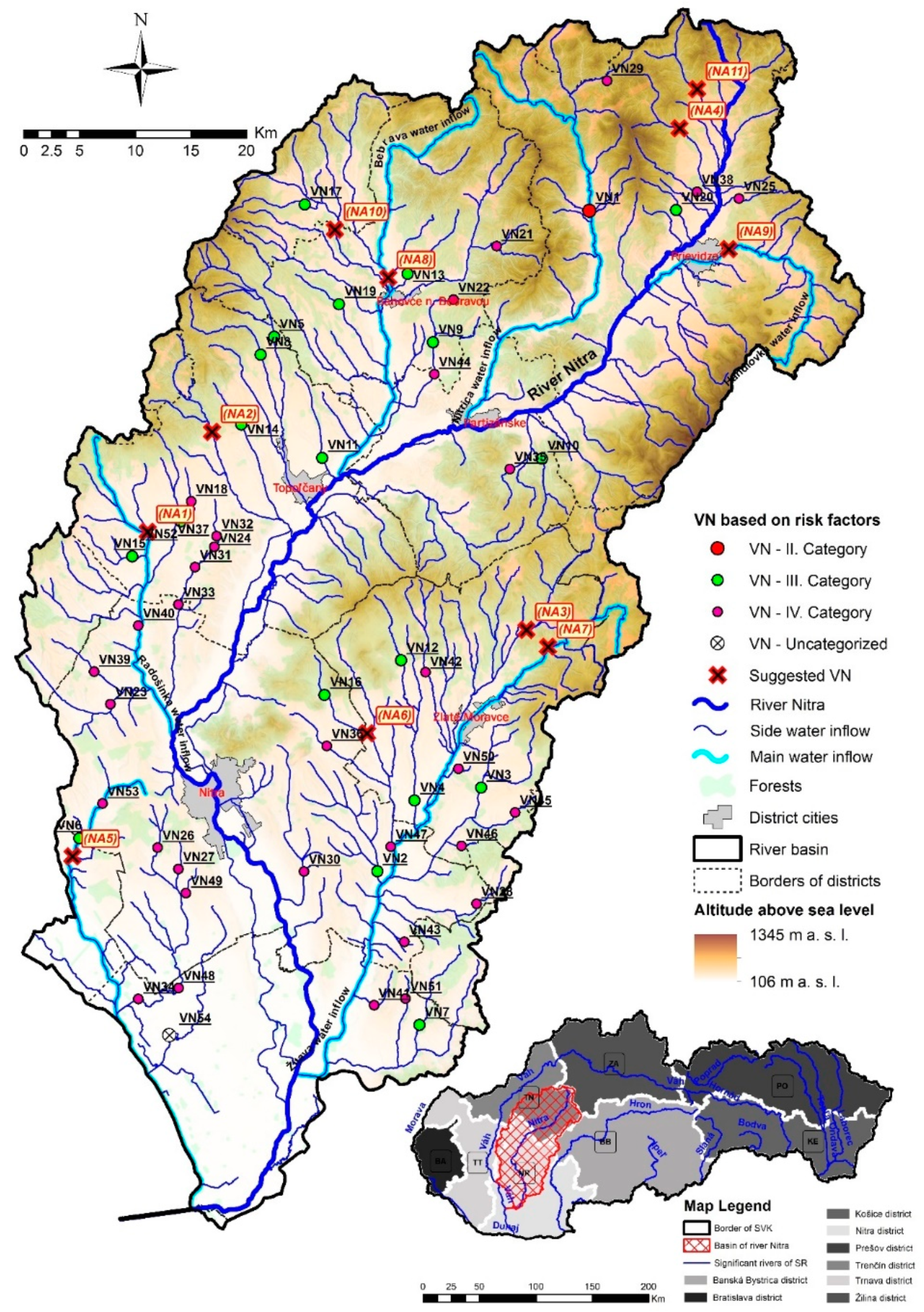
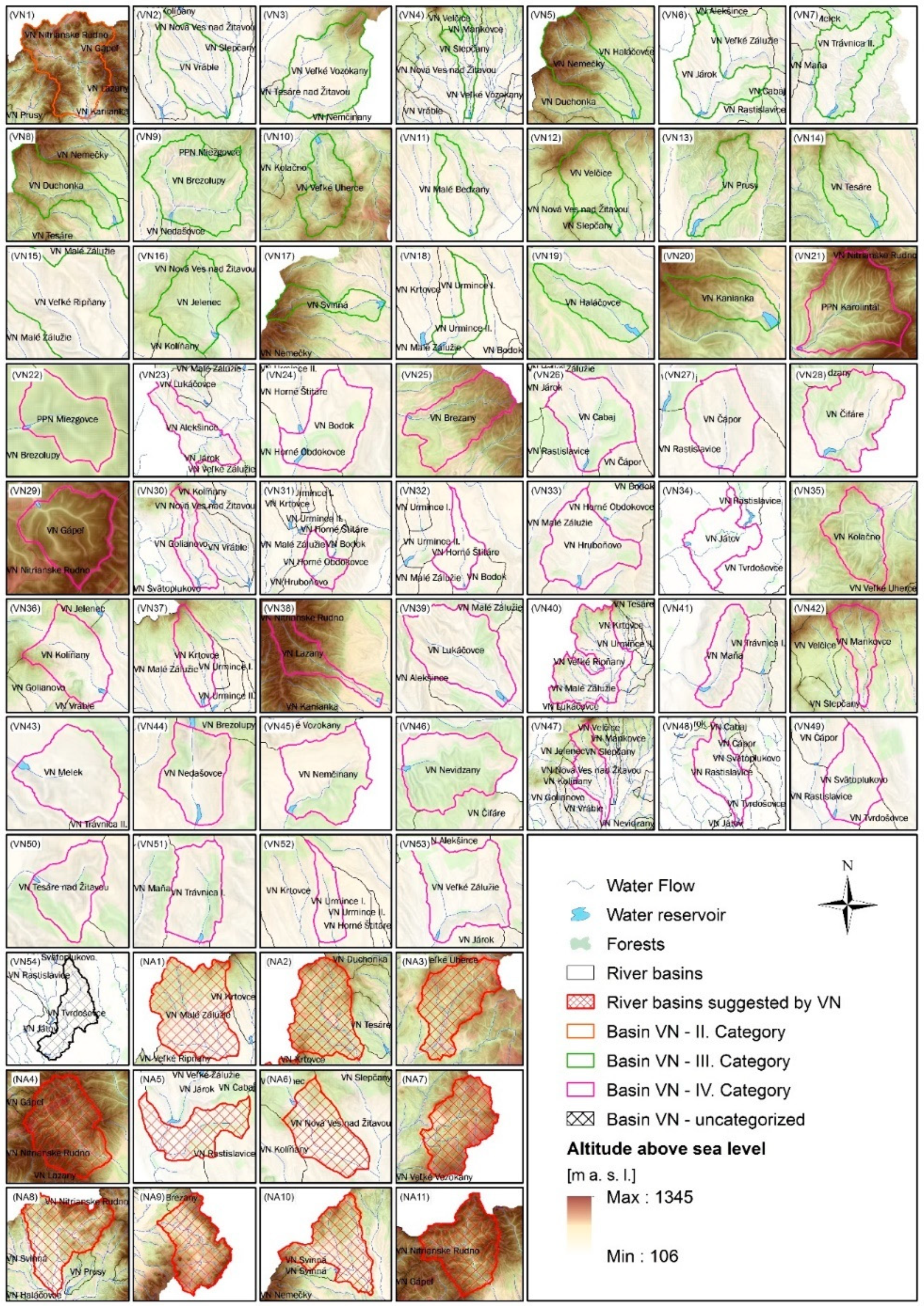
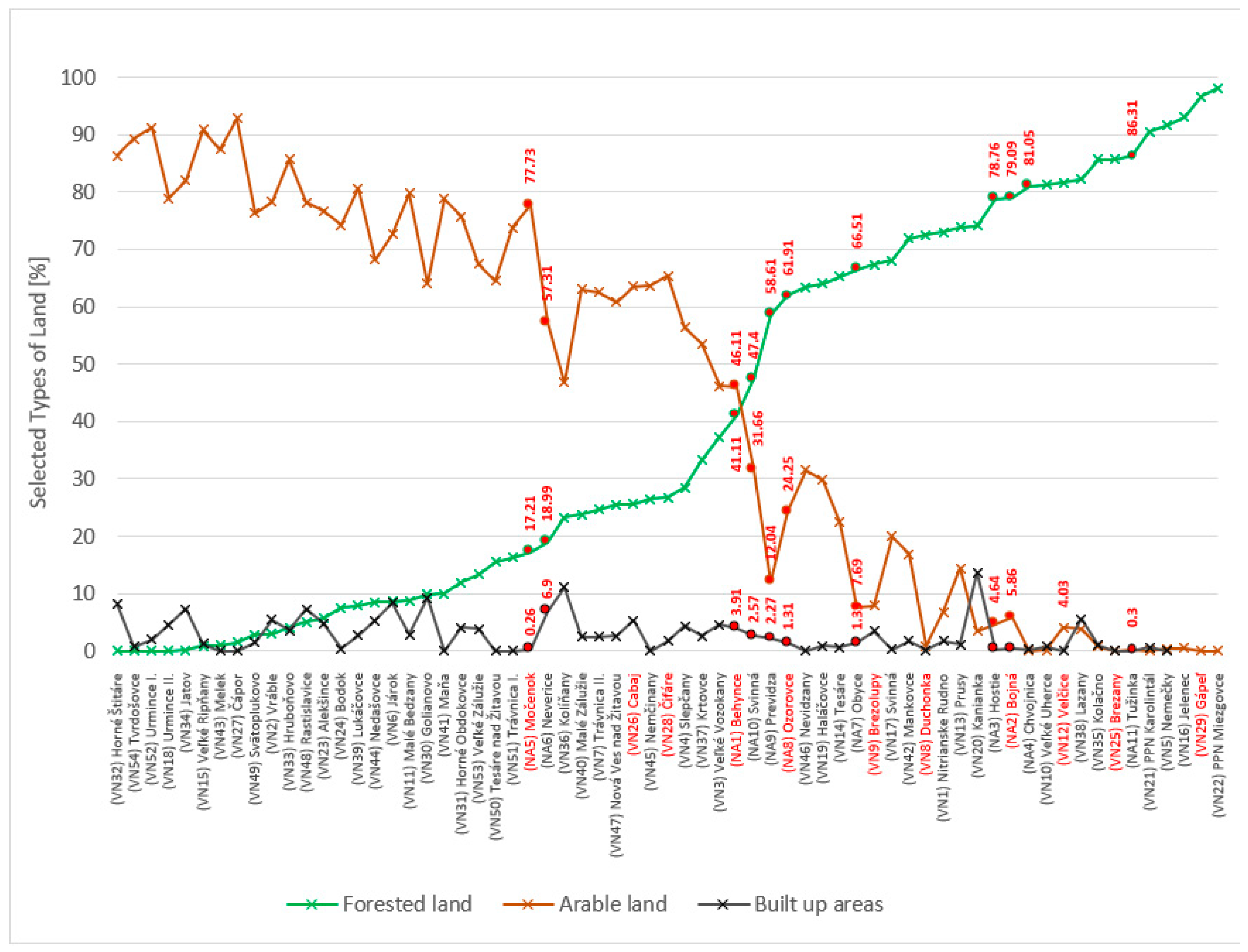
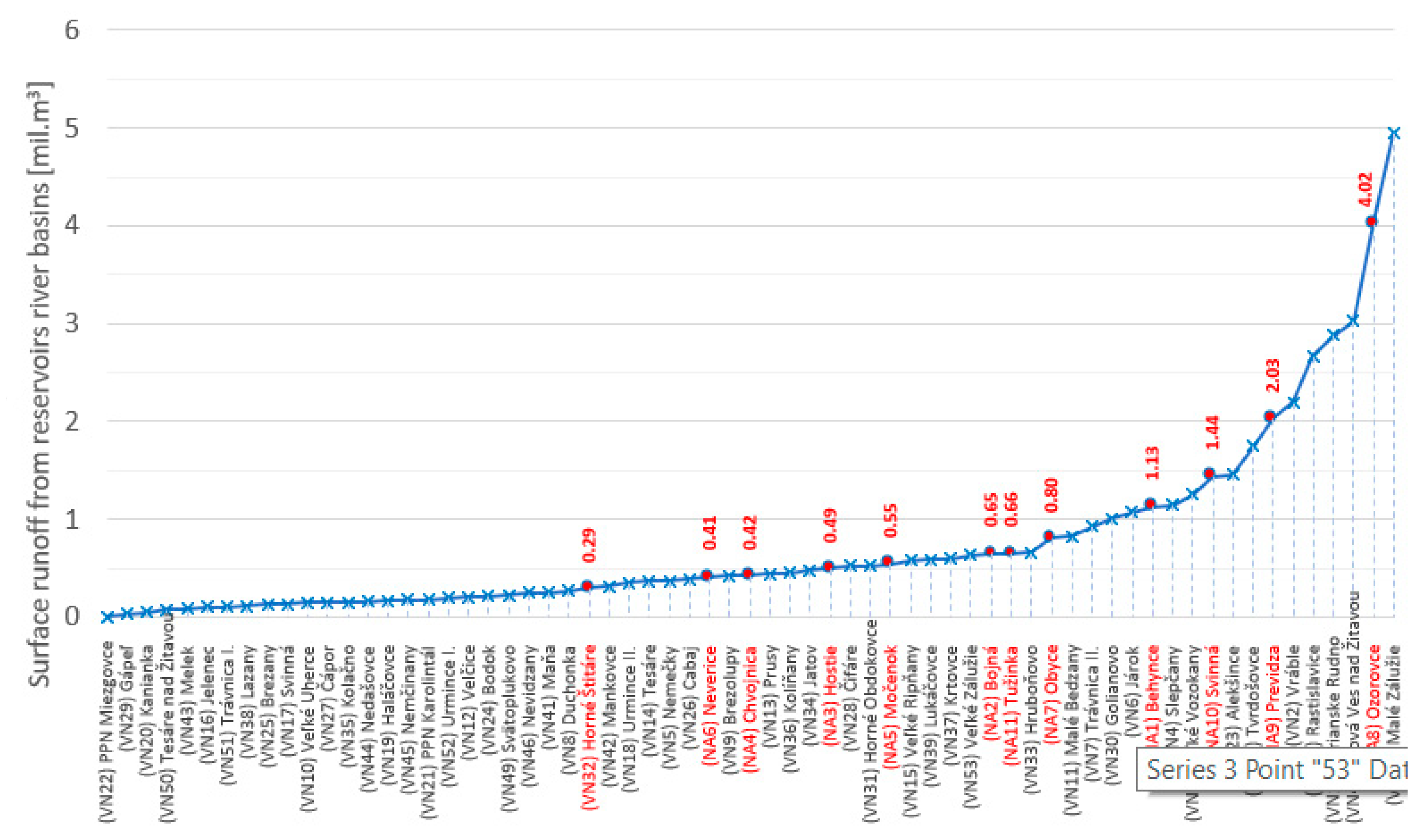


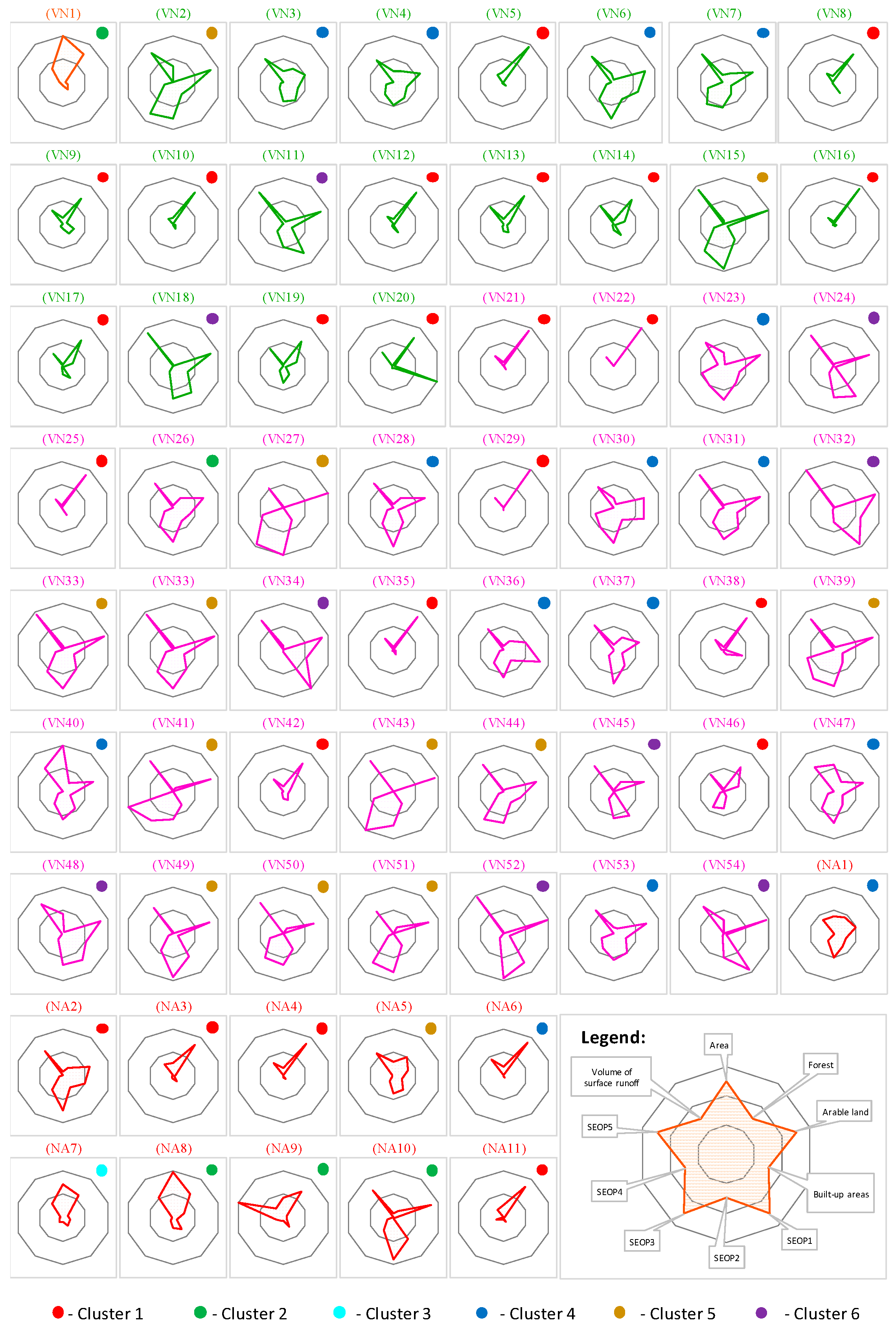
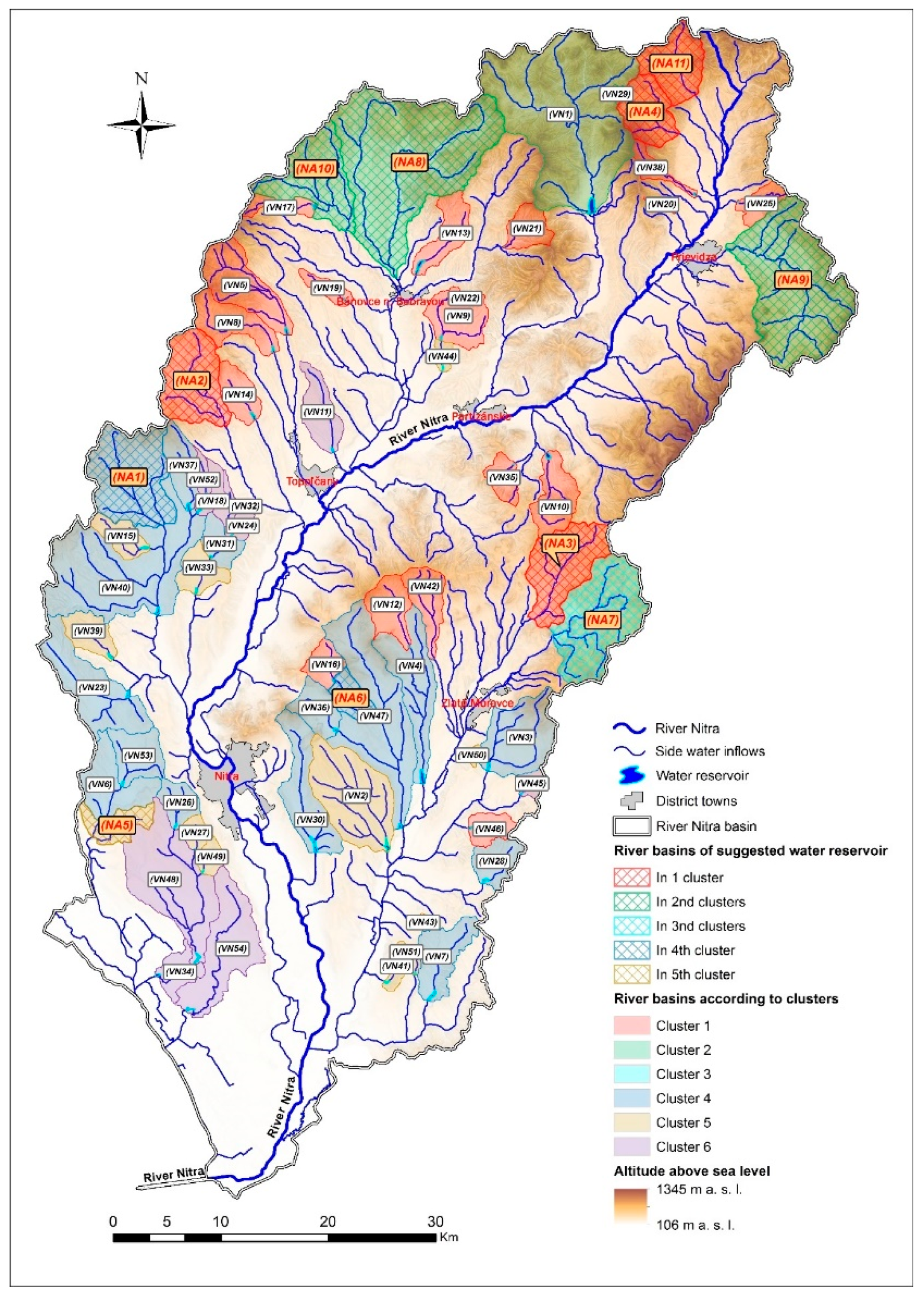
| Risk Factor Categories | Number of Sites | Ranges of Risk Factor “F” |
|---|---|---|
| II | 1 | 150 ≤ F < 1000 |
| III | 19 | 15 ≤ F < 150 |
| IV | 33 | 1 ≤ F < 15 |
| Uncategorized | 1 | Tvrdošovce (VN54) |
| Clusters 1–6 | Area of Basin | Forested Land | Arable Land | Built-up Area | SEOP 1 | SEOP 2 | SEOP 3 | SEOP 4 | SEOP 5 | Surface Runoff from Reservoirs River Basins |
|---|---|---|---|---|---|---|---|---|---|---|
| (km2) | (km2) | (km2) | (km2) | (-) | (-) | (-) | (-) | (-) | (m3) | |
| Min.: | 0.55 | 0.0000 | 0.0000 | 0.0000 | 0.00000 | 0.00000 | 0.00000 | 0.00000 | 0.00000 | 6773 |
| 1st Qu.: | 8.01 | 0.0861 | 0.0681 | 0.0026 | 0.16120 | 0.01289 | 0.01406 | 0.00003 | 0.00000 | 17,079 |
| Median: | 15.57 | 0.2672 | 0.5636 | 0.0167 | 0.26010 | 0.11444 | 0.05788 | 0.00143 | 0.00000 | 30,236 |
| Mean: | 29.05 | 0.4053 | 0.4472 | 0.0265 | 0.28850 | 0.09709 | 0.10785 | 0.00877 | 0.00003 | 27,860 |
| 3rd Qu.: | 35.82 | 0.7298 | 0.7628 | 0.0411 | 0.36550 | 0.16299 | 0.18567 | 0.01060 | 0.00000 | 36,231 |
| Max.: | 157.89 | 0.9818 | 0.9287 | 0.1369 | 0.83900 | 0.23497 | 0.42985 | 0.08405 | 0.00125 | 50,416 |
© 2020 by the authors. Licensee MDPI, Basel, Switzerland. This article is an open access article distributed under the terms and conditions of the Creative Commons Attribution (CC BY) license (http://creativecommons.org/licenses/by/4.0/).
Share and Cite
Gacko, I.; Muchová, Z.; Jurík, Ľ.; Šinka, K.; Fabian, L.; Petrovič, F. Decision Making Methods to Optimize New Dam Site Selections on the Nitra River. Water 2020, 12, 2042. https://doi.org/10.3390/w12072042
Gacko I, Muchová Z, Jurík Ľ, Šinka K, Fabian L, Petrovič F. Decision Making Methods to Optimize New Dam Site Selections on the Nitra River. Water. 2020; 12(7):2042. https://doi.org/10.3390/w12072042
Chicago/Turabian StyleGacko, Igor, Zlatica Muchová, Ľuboš Jurík, Karol Šinka, Ladislav Fabian, and František Petrovič. 2020. "Decision Making Methods to Optimize New Dam Site Selections on the Nitra River" Water 12, no. 7: 2042. https://doi.org/10.3390/w12072042
APA StyleGacko, I., Muchová, Z., Jurík, Ľ., Šinka, K., Fabian, L., & Petrovič, F. (2020). Decision Making Methods to Optimize New Dam Site Selections on the Nitra River. Water, 12(7), 2042. https://doi.org/10.3390/w12072042






